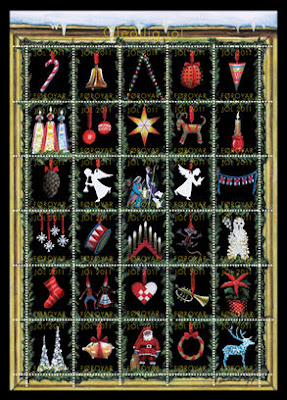
There are songs which seem to enter people's consciousness easier than others. Songs, which for some reason touch something deep in our minds. Words, storyline and tune, which together create a familiar image - a memory, a dream or just the feeling of an idealized moment.
These are the characteristics of the classics, and this year's carols are examples of those exact qualities. Although quite different in expression, both songs manage to create impressions and images of the indefinable pleasure and anticipation that we all associate with our childhood’s Christmas
I can’t wait for Christmas to come
The motif of the 6.50 stamp is based on the modern Faroese Christmas classic, "Eg eri so spent til jóla" – “I can’t wait for Christmas to come.” The music was written by Jóhannus á Rógvu Joensen and lyrics by Ella Smith Clementsen.
The song and the story is, briefly, about the six-year old Margreta who has problems with controlling her longing and expectations for Christmas. In her restlessness she goes out for a walk and in Tórshavn’s old café, she meets a pixie-girl, who takes her out on adventures that only six year olds can experience.
Ella Smith Clementsen b. 1952 is one of the most famous children's authors on the Faroes. She has written and translated a large amount of children's books, children's songs and pieces for radio and television and works as a freelance writer. In 1994, Ella recieved Tórshavn town council children's book prize.
In 1989, Ella Smith Clementsen together with composer and musician Jóhannus á Rógvu Joensen b. 1959. Ella had written some children's songs which Jóhannus set to music. When Jóhannus approached her about writing a few extra songs, Ella wrote "I can’t wait for Christmas to come," which has since proved to be one of the most popular Christmas and children's songs ever on the Faroe Islands.
The rest is history. The six-year Margreta who was looking forward to getting a new dress and went out on an adventure with the pixie girl, walked straight into the Faroese cultural consciousness and has stayed there ever since. A small figure with great symbolic importance for the modern view of Christmas.
I rejoice every Christmas Eve
131 years before Ella Smith Clementsen sat by the window and wrote her little Christmas song, another woman was doing exactly the same.
On Christmas Eve 1858, 26 year old Marie Wexelsen (1832-1911) sat in the parents' kitchen in Sukkestad, Norway, waiting for the Christmas guests to arrive. As she sat there and looked out the window, she came to think of her childhood Christmas, and began in her mind to formulate a Christmas song. A few days earlier she had completed a short story "Kjetil - A little Christmas present for the child", and the poem she puzzled with, should be the introduction to the story.
The story of Kjetil was published in 1859 and subsequently in several new editions. But while few people today know the story itself, the poem in the introduction became one of the greatest Nordic Christmas classics, namely the song "Jeg er saa glad hver julekveld". The song has been translated into all Nordic languages and also to Faroese titled "Eg gleðist so hvørt jólakvøld" by Dean Jákup Dahl.
It's hard to imagine a Christmas without the warm singing of childlike faith, and the beautiful picture of mother who walks around in the house and lighten all candles. For life, for family, her own child and the Infant Jesus.
Marie Wexelsen was also a child of her time. She lived at home with parents until their death, and then, from 1880, in Christiania (now Oslo), where she was a teacher at Hamar. In 1890 Marie and her older sister Rikki moved to Trondheim, where they ran a small school. Marie, who remained unmarried throughout life, was strongly influenced by the Grundtvigian outlook, which broke with the dismal Christianity, and called for educating and informing the people. She wrote three novels, three children's books, a series of poems and various articles on social affairs, religion and language policy issues. One senses a protest against society's oppression of women in her writings, but like so many other women of her time, her involvement in social conditions was partly rooted in a bright and positive Christianity.
When Marie Wexelsen died in Trondheim in 1911, children with lighted candles sang: "I rejoice every Christmas Eve" at her funeral.
Two very different songs, but with so many similarities. Wexelsens childlike joy over the message of Christmas and the little Christ child - or Smith Clementsens captivating tale about the girl who looks forward to getting a new dress and her travel in the mythical universe of Christmas. Both are classics and remind us to stay in the holiday’s purest form - Christmas seen through the hopeful eyes of a child.
Anker Eli Petersen
Technical data:
Values: stamps of 6.50DKK and 10.50DKK
Date of issue: 28-IX-2011
Author: Anker Eli Petersen
Perforation:
Technique: Offset
Printer: Enschedé, Netherlands





